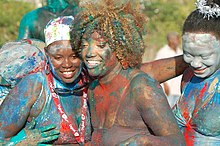Afro-Anguillians
This article needs additional citations for verification. (July 2024) |
| Total population | |
|---|---|
| Approx. 14,194 | |
| Regions with significant populations | |
| Languages | |
| English | |
| Religion | |
| Christianity | |
| Related ethnic groups | |
| Afro-Caribbean |
Afro-Anguillians or Black Anguillians are Anguillian whose ancestry lies within the continent of Africa, most notably West Africa.[citation needed]
As of 2013, people of solely African descent are the majority ethnic group in Anguilla, accounting for 90.1% of the country's population. An additional 4.6% of the country is mulatto.[1]
History
[edit]

Before the arrival of Europeans in the Caribbean, Anguilla was inhabited by Arawakan-speaking Native Americans who called the Island Malliouhana. Anguilla was colonized in 1650 by British settlers from Saint Kitts and thereafter become a British colony. The British did not encounter any Arawaks in Anguilla, but in 1656 a raid by Native Americans from one of the neighbouring islands wiped out their settlement. The early years were difficult for the European colonists. Due to increase demand for sugar in Europe, British colonizers began producing sugarcane using enslaved Africans.[2] Several mixed-race mulatto slaves that were children of their masters were often willed freedom and in some cases willed land. In addition to the mulatto class of manumissions, there are cases of Anguillian slaves being rented for their labour to other islands and using the compensation to purchase their freedom and plots of land for paltry sums, as the land was often seen as fruitless by their previous masters.
References and footnotes
[edit]- ^ a b "CIA - The World Factbook -- Cayman Islands". CIA. Retrieved 2013-06-09.
- ^ "Anguilla - History | Britannica".
